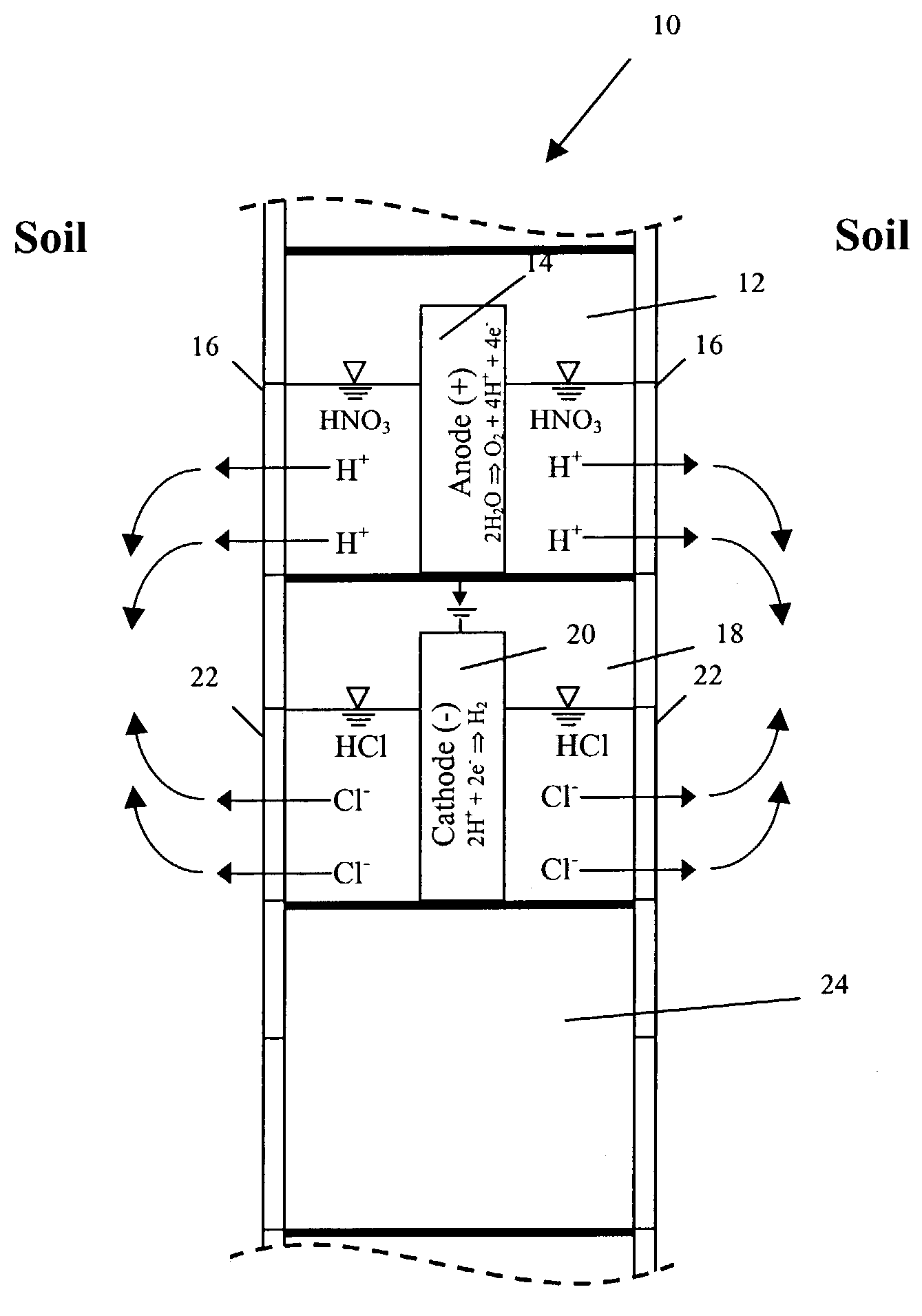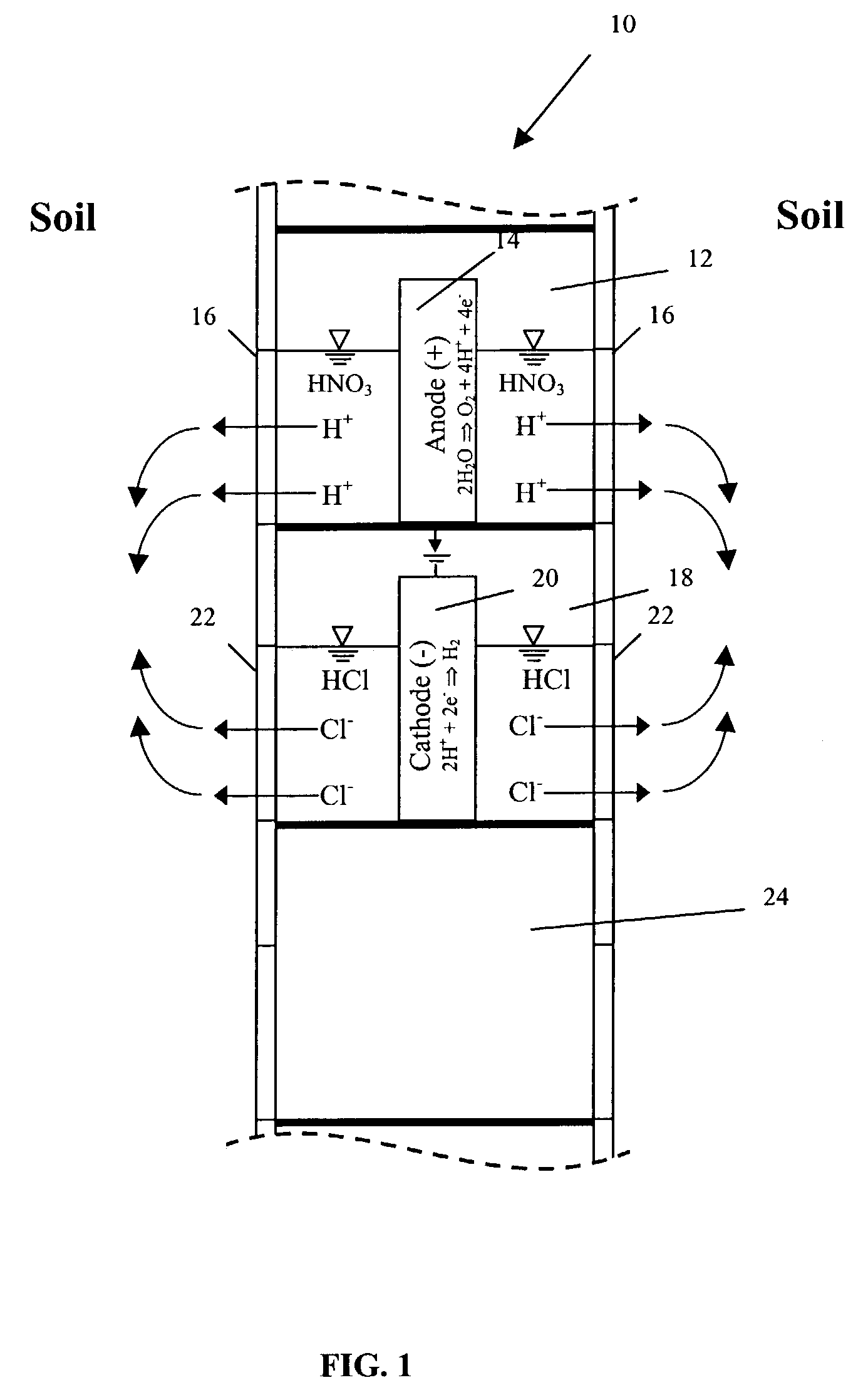2. The word “soil” and the like (whether as a
noun or
adjective) includes but is not limited to unconsolidated matter (whether anthropogenic, natural, organic, or inorganic) such as
sediment, sand, clay,
slurry, mine
tailings, and organic material;
3. The word “contaminated” and the like when used in relation to the word “soil” and the like shall be understood as referring to that portion of unconsolidated matter that is contaminated, in any way whatsoever, whether voluntarily or otherwise, and shall be understood as referring to that portion of a “medium” that is contaminated, in any way whatsoever, either voluntary or otherwise;
4. The expression “electrokinetic phenomena” and the like shall be understood as referring to the primary electrokinetic transport mechanisms of
electrophoresis,
electromigration, and electroosmosis that occur when a direct
voltage is applied across electrodes placed in a
soil mass.
Electrophoresis is the movement of charged colloids (i.e., clay particles, micelles, organic particles,
metal oxides) within the pore solution.
Electromigration is the movement of ions to their respective electrodes. Electroosmosis (the transport of solutes in the pores of the soil due to the movement of the
soil solution in an applied
electric field) is particularly relevant here and bears some discussion. Double layer theory in soils postulates (a) the
free water layer and (b) the boundary film of water within the diffuse electric double layer surrounding clay particles, organic colloids, and
metal oxides. To maintain electroneutrality, counterions are associated with the
charged particle surfaces. Under normal hydraulic flow, it is usually assumed that the boundary water film is not affected and only water within the free layer moves under the hydraulic gradient. (In actuality, the two water “
layers” are a continuum, and the boundary between the
layers is not clearly defined). Under the influence of an
electric field, the counterions and their associated water molecules on the particle surfaces will migrate towards their respective electrodes. This movement imparts a net strain on the
pore fluid around the hydration shell of the counterions, causing a net
shear force to develop through the
viscosity of the
pore fluid. The net
shear force and
momentum cause the boundary film of water and
free water to move. The thicker the diffuse double layer and the smaller the pore size, the more uniform is the strain field and the farther it extends into the center of the capillary. Because of the pore size effect, electroosmosis is only significant in low permeable soils. Also, since most soil surfaces have net negative charges, the movement of the pore solution due to electroosmosis is usually towards the
cathode.
5. The words “
hydrogen ion” and “
proton” and the like (whether singular, plural or as a noun or adjective) include but are not limited to hydrated
proton(s) and
hydronium ion(s).
6. The expression “accelerated
water splitting” and the like shall be understood as referring to the accelerated dissociation of water into
hydrogen and
hydroxide ions which occurs at bipolar interfaces between
ion exchange membranes and low permeable soils. (See, Desharnais, B. M. and B. G. Lewis “Electrochemical
Water Splitting at Bipolar Interfaces of
Ion Exchange Membranes and Soils”,
Soil Science Society of America Journal, Vol. 66, no. 55 (2002); 1518-1525.) If an
ion exchange membrane placed in contact with a soil has an electrostatic charge opposite in sign to the predominant charge on the soil colloidal particles, the interface is, in effect, bipolar. If an external
electric field is then applied across the interface, conditions can give rise to accelerated
water splitting, similar to the conditions found in bipolar
ion exchange membranes. Accelerated
water splitting occurs when the free pore solution in the low permeable soil moves away from the bipolar interfaces due to electroosmosis, thus causing an unsaturated zone at these interfaces. Accelerated water splitting then initiates at these interfaces since there are not enough counterions in contact with the IEMs to maintain an ionic current.
The accurateness of this monitoring will dictate not only the type of remediation to be implemented but also the cleanup expense of the site.
The prior art includes several techniques, the disadvantages of which have prompted the search for an improved apparatus and methodology, particularly for sampling and / or collecting low concentrations of cationic and anionic contaminants.
Of the many problems associated with drilling, a primary issue is the handling of contaminated cuttings.
However, the tradeoff with small samples is the risk of not collecting a detectable or representative amount of the contaminant.
Second, drilling large boreholes and placing monitoring equipment such as lysimeters, pumps, and casings may significantly disturb the surrounding soil.
A third problem is cost.
A fourth problem is ease of use.
Drilling techniques such as hollow stem augers, direct rotary mud drilling, and core drilling may be complicated and
time consuming.
Pumping considerations,
drilling fluid viscosities, and correct selection of rotary speeds and applied axial forces all significantly complicate drilling.
Disadvantages are also associated with media samplers.
Again, in the soil context, as with all soil samplers (i.e., those which actually remove soil from the subsurface), the act of soil extraction may chemically and physically disrupt the soil sample.
Likewise, some samplers do not collect representative samples.
In addition, the removal of the soil does not lend itself to repeatedly sample the same
aquifer location again.
Further, very few samplers are effective in both the saturated and unsaturated zones.
Aside from samplers that extract soil, few samplers are effective in
low permeability clays and silts.
Yet another problem is that some sampling techniques are
time consuming.
The aforementioned concerns and deficiencies are discussed in the soil context, but comparable issues persist with other contaminated media, such as ground and
surface water.
 Login to View More
Login to View More 


